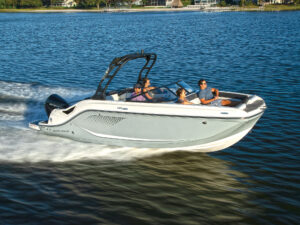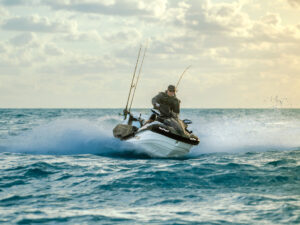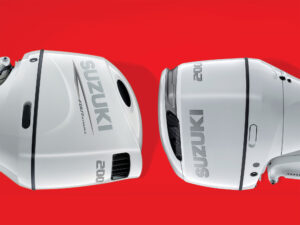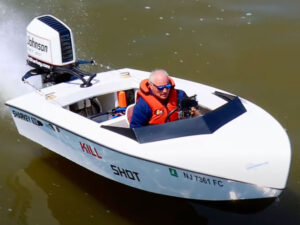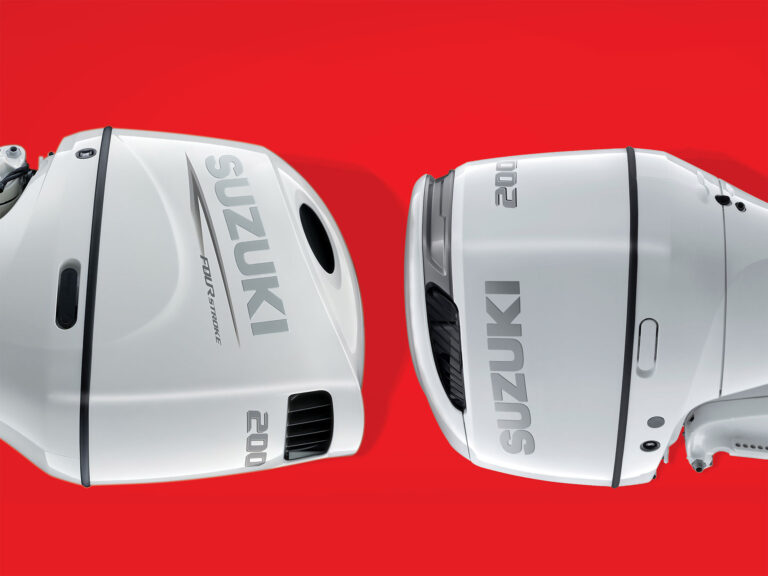As the No Wake sign came abeam, I put the throttles down, slingshotting our test crew onto plane. The smooth delivery of power and the gobs of torque that got the boat up, and held it there in big swells without undue throttle jockeying, impressed me. Later, I’d be equally impressed when calculating our fuel burn. But at that moment, as the day began in earnest, what stood out most was the noise, or the lack of it.
Dual turbochargers, rather than a supercharger/turbocharger combination, create forced induction and feed air to the TDI 4.2 350s. Turbo whine and a supercharger’s whistle are sounds those of us who run diesel-powered boats have become inured to, the price paid for delivering more air to the cylinders, which, in turn, allow more fuel to be burned, and so increase power. In simplest terms, both superchargers and turbochargers are air pumps, or compressors. The difference lies in how they are driven. Superchargers are mechanically driven by belts or gears, like an alternator. A turbo uses the stream of engine exhaust gas to spin turbines.
The beauty of the CMD TDI series is that the dual turbos are vacuum-controlled and feature a variable geometry that allows for excellent forced induction without the whistle, and little of the whine, typically associated with supercharged/turbocharged marine diesels. The T in TDI stands for “turbo.”
The DI refers to the common-rail direct fuel injection. Common-rail fuel delivery systems use a high-pressure rail to feed individual piezoelectric injectors, unlike our dads’ diesels, which used a fuel pump to feed individual unit injectors. Common-rail direct injection helps lower engine noise as well, since a minute, preliminary charge of fuel can be delivered prior to each cylinder’s main combustion event, reducing the explosiveness and thus reducing noise. Of course the benefits of such a system on your boat’s range and economy of operation are huge.
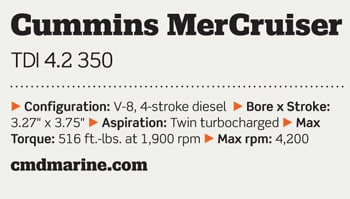
Go the Distance
Cummins MerCruiser Diesel offers TDI series engines for use in either inboard or sterndrive applications. I tested twin 350 hp TDI 4.2 350s hooked to Bravo Three XR sterndrives turning 25-inch-pitch XR propsets through 1.81:1 reductions. These were installed in an 11,000-pound Statement Marine 37 carrying 100 gallons of fuel and a crew of six grown men. After computing the fuel burn it was easy to understand why Chris Fertig chose CMD TDI diesels to power this Statement 37 in a bid for the 760-mile endurance test that is the Bermuda Challenge (boatingmag.com/bermudachallenge). These are great numbers.
Our most economical cruising speed occurred at 2,700 rpm. Here the engines delivered 28 mph burning 11 gallons per hour for a net economy of 2.22 miles per gallon. Throttling up to 3,000 rpm, we cut through the water at 35 mph burning 15.2 gallons per hour total for a net economy that still exceeded 2 miles per gallon. As propped, the TDI 4.2 350s turned 4,160 rpm at wide-open throttle, delivering a 51 mph top speed burning 40.8 gallons per hour and an economy of 1.1 miles per gallon.
EPA Tier 2 certified, these are considered “clean diesels.”
Charged Up
Back at the dock, we popped the hatch and examined the engines. We spotted the easy access to the oil filter right away and made note of the overall good serviceability made possible by such a small footprint, given the horsepower. At 811 pounds (without the drive) the 4.2 TDI features a horsepower-to-weight ratio of 0.43. Such a great ratio is ideal for a marine application and also leaves no doubt as to why these engines see service in performance-oriented cars such as the Audi Q7. That’s right, these TDI diesels are the same blocks as those found in Volkswagen automobiles. At 120 amps, the alternator output is more than enough to power today’s electrically and electronically laden boat systems and provides charging reserve for generously sized banks of batteries.
Need One?
The test boat was a go-fast, but these engines are suitable for a wide variety of applications, from fish boats to cruisers to large yacht tenders. The TDI series is available from a 40 hp four-banger to the 350 hp V-8 I tested. We believe that the V-8, as well as the 3.0-liter V-6 (225 to 265 hp), will be of most interest to Boating‘s audience of mariners.
Key Features
1. Twin turbochargers help deliver plenty of power and torque throughout the rpm band.
2. Common-rail fuel delivery makes for low smoke, low noise and exceptional economy.
3. Compact footprint and a svelte power-to-weight ratio make these great candidates for repower and replacement applications.
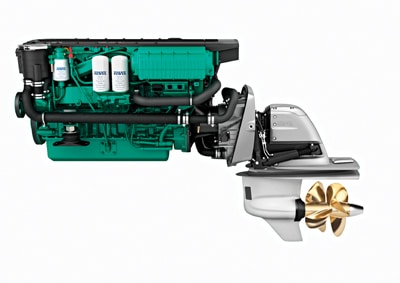
Another Choice
Volvo Penta’s D6-370 is a turbocharged, after-cooled, six-cylinder diesel weighing 1,279 pounds. Its alternator output is 80 amps, and it can be had with electronic controls and electronic vessel control (EVC) engine monitoring and diagnostics (volvopenta.com).

